Learn how the number 15 symbolizes divine deliverance and judgment in biblical narratives, revealing deeper layers of faith and redemption.

Number 15 in the Bible
In the realm of biblical symbolism, the number 15 stands as a beacon of deliverance and judgment, a juxtaposition that intrigues and puzzles. You'll find that its appearances, from the solemn observance of the Passover on the 15th day to Hezekiah's miraculous healing, weave a complex tapestry of divine intervention and human response.
As you explore the layers behind this seemingly ordinary number, you'll uncover insights into faith, redemption, and the intricate ways the divine narrative interacts with mortal lives. This journey promises revelations that might change how you view the mundane, urging you to look closer at what lies beneath the surface.
Key Takeaways
- The number 15 symbolizes rest, deliverance, transition, and redemption in biblical numerology.
- Passover, beginning on the 15th of Nisan, embodies liberation, renewal, and the start of deliverance.
- The Feast of Unleavened Bread, following Passover, represents purity, redemption, and spiritual cleansing.
- The healing of Hezekiah and rebuilding of Jerusalem's walls highlight faith's transformative power and divine favor connected with the number 15.
The Significance of 15

In biblical numerology, the number 15 symbolizes rest and deliverance, a theme deeply embedded within various scriptural narratives. Your examination of this number through numerology analysis reveals layers of meaning that extend beyond its mere appearance in texts. The figure 15 emerges not just as a marker of historical events but as a profound symbol of transition and redemption. This insight isn't merely academic; it carries personal implications for you, offering a lens through which to interpret life's challenges and victories.
The scholarly approach to understanding the significance of 15 in the Bible necessitates a dive into instances where the number directly impacts the unfolding of God's plan for His people. For instance, the cessation of a certain period or the fulfillment of a promise on the 15th day underlines the idea of deliverance and rest after trials. This isn't coincidental; it's a pattern that speaks to the deliberate design of biblical narratives.
For you, this analysis isn't just about uncovering historical or theological facts. It's about finding a personal resonance with the themes of rest and deliverance symbolized by the number 15. It invites you to reflect on your own life's journey through the lens of biblical numerology, searching for moments of rest and deliverance that align with this significant number.
Passover: A Beginning
Exploring the significance of the number 15 further, consider how Passover marks a pivotal beginning in the narrative of deliverance and rest, embodying these themes at a foundational level. This Jewish festival, deeply rooted in the history of the Israelites' exodus from Egypt, aligns with the lunar calendar, specifically on the 15th day of Nisan. It's not just a historical commemoration but a symbol of liberation and the start of a journey towards freedom.
The Passover's placement on the lunar calendar underscores its connection to cycles of renewal and rebirth, resonating deeply with themes of deliverance. This timing is integral, as it reflects the natural world's rhythms and the cyclical pattern of hardship and relief, bondage and freedom.
Moreover, the Passover's significance as a beginning is further amplified when you draw an Easter comparison. Both holidays represent profound transformations and new beginnings, though they emerge from different traditions. Easter, celebrated by Christians, marks the resurrection of Jesus Christ and is often linked to the concept of redemption. This parallel underscores the universal themes of renewal and hope inherent in both festivals, despite their distinct origins and practices.
Feast of Unleavened Bread
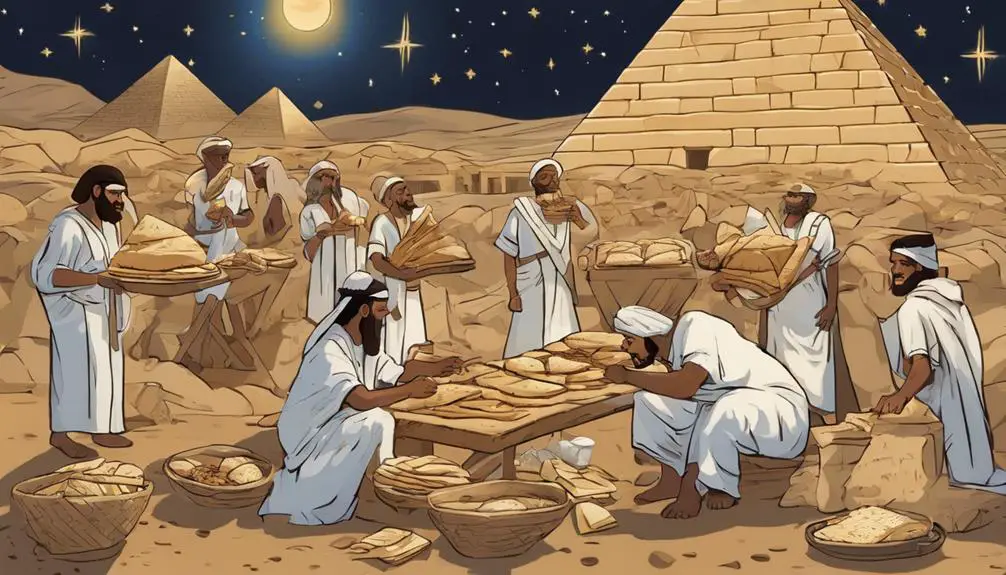
Immediately following Passover, you'll find the Feast of Unleavened Bread, a seven-day observance that holds deep symbolic meaning within the Jewish tradition, emphasizing purity, redemption, and a collective remembrance of haste. This festival's Egyptian origins are pivotal, reflecting the Israelites' urgent departure from Egypt, during which there was no time to let bread rise. Thus, unleavened bread, or matzah, becomes a poignant symbol of their swift flight to freedom.
Analyzing the cultural adaptations of this observance, it's evident that the feast has evolved while retaining its core significance. Over centuries, various Jewish communities have imbued the festival with local customs, yet the abstention from leavened bread as a unifying practice underscores a shared historical consciousness. This adaptation process reflects an enduring commitment to memory and identity, demonstrating how a ritual rooted in ancient exigency remains relevant in expressing collective values and ethics.
Moreover, the meticulous cleaning of homes to remove any leaven symbolizes a spiritual cleansing, aligning physical purification with moral and ethical renewal. Thus, the Feast of Unleavened Bread transcends its historical origins, offering a timeless framework for reflection on liberation, purity, and communal solidarity.
Hezekiah's Healing
Hezekiah's healing, as recounted in the biblical narrative, stands as a profound testament to the interplay of faith, divine intervention, and personal transformation within the Judaic tradition. This episode unfolds against the backdrop of Hezekiah's pride and the Assyrian siege, both pivotal elements that shape the context of his miraculous recovery. You'll find that Hezekiah's pride initially led to his illness—a divine reprimand for his arrogance and failure to attribute his successes, notably his resistance against the Assyrian siege, to divine providence.
The narrative intricately weaves these elements to highlight a critical juncture in Hezekiah's life, where personal pride and national crisis intersect with divine intervention. The Assyrian siege, a significant threat to the kingdom, underscores the precariousness of Hezekiah's situation, both physically and spiritually. His healing, therefore, isn't merely a restoration of health but a symbolic reaffirmation of faith and divine favor, marking a pivotal transformation in Hezekiah's reign and personal journey.
This account serves as a scholarly exploration of the complexities inherent in the relationship between divine will, human agency, and the consequences of pride, set against the backdrop of a nation under siege. It's a narrative that resonates with themes of repentance, humility, and the transformative power of faith.
The Walls of Jerusalem
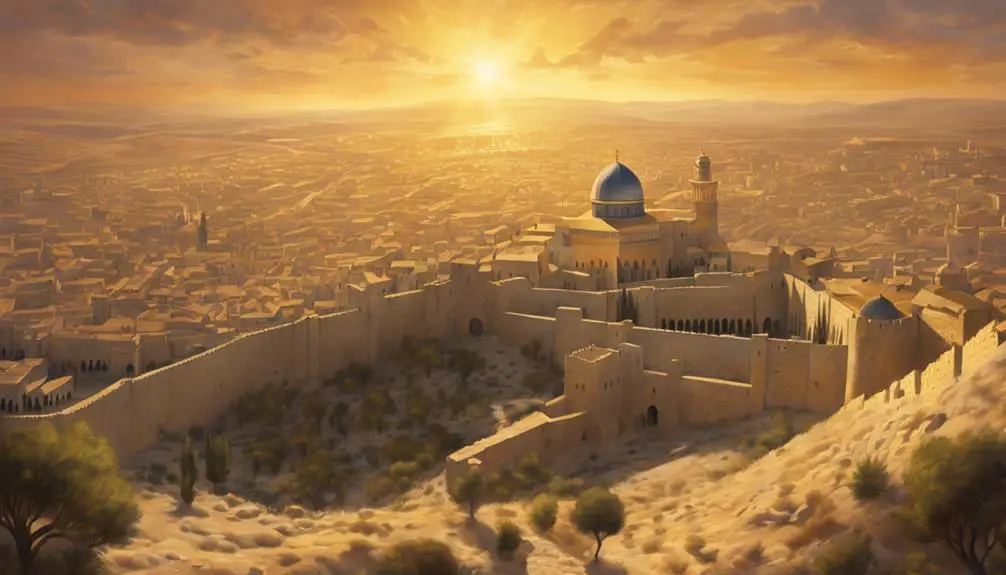
Reflecting on Hezekiah's miraculous recovery and the divine favor it symbolized, it's essential to examine the significant role the Walls of Jerusalem played in the narrative of faith and fortitude within the Judaic tradition. The construction and restoration of these walls, particularly under Nehemiah's leadership post-Babylonian exile, not only mark a physical rebuilding but also a symbolic resurgence of Jewish identity and divine protection.
Nehemiah's leadership was pivotal in overcoming opposition and rallying the returned exiles towards a common goal: the re-establishment of Jerusalem's boundaries. This physical act of rebuilding was interwoven with spiritual renewal, signaling a return to covenantal faithfulness and the reassertion of divine favor upon the people.
Aspect |
Significance |
Outcome |
|---|---|---|
Nehemiah's Role |
Catalyst for reconstruction and spiritual revival |
Strengthened identity |
Babylonian Exile |
Context of loss and longing for homeland |
Renewed faith |
Divine Favor |
Symbolized by successful rebuilding amid opposition |
Reaffirmed protection |
This narrative arc, from despair during the Babylonian exile to hope under Nehemiah's stewardship, encapsulates a journey of faith, resilience, and divine providence, reinforcing the Walls of Jerusalem as symbols of God's unwavering support for His people.
Rainfall and Divine Favor
Throughout biblical history, rainfall has often been interpreted as a manifestation of divine favor, serving as both a physical necessity and a spiritual symbol for the people of Israel. This perception is deeply rooted in the agricultural society of ancient times, where rain was essential for survival. Climate symbolism in the Bible isn't merely incidental; it's woven into the narrative to convey messages of hope, renewal, and divine blessing.
Seasonal metaphors are particularly potent, with the onset of rain symbolizing a time of God's grace and favor. In arid regions, the arrival of rain signifies the transition from a period of barrenness to one of fertility and abundance. This transition isn't just agricultural but spiritual, suggesting that divine intervention in the form of rainfall can transform a period of spiritual dryness into one of growth and prosperity.
The scholarly interpretation of these themes suggests a complex understanding of the relationship between God and humanity, mediated through the natural world. Rainfall, therefore, becomes a sign of God's covenant with His people, a tangible expression of divine love and mercy. It's not just weather; it's a symbol of the divine promise of provision and care, deeply embedded in the cultural and theological fabric of biblical narrative.
Offerings and Sacrifices
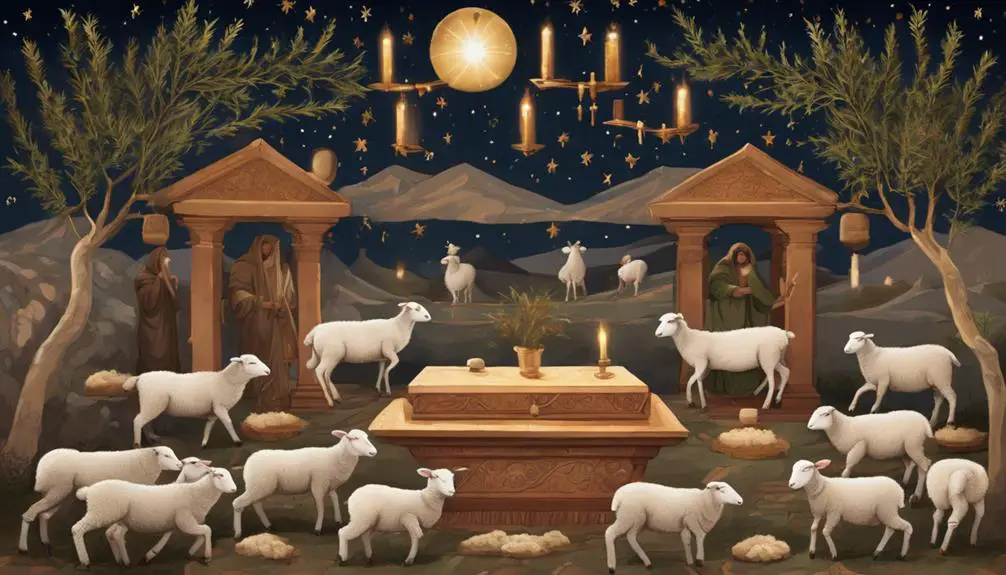
Similarly to how rainfall symbolizes divine favor, offerings and sacrifices in the Bible represent a fundamental aspect of worship and communication with God, underscoring the importance of obedience and devotion in the spiritual lives of the believers. The practice of making offerings and sacrifices is deeply rooted in notions of ritual purity and animal symbolism, each element meticulously chosen to convey specific theological messages and uphold the sanctity of the act.
Animal sacrifices, for instance, aren't merely ritualistic acts but are imbued with rich symbolic meaning. Certain animals are selected based on their perceived purity and symbolic associations, reflecting broader themes of atonement, thanksgiving, and supplication. The unblemished lamb, for example, represents innocence and purity, making it an apt symbol for the sacrificial system that seeks to restore harmony between the divine and the human realms.
Moreover, the emphasis on ritual purity extends beyond the choice of the animal to the very process of offering the sacrifice. This process involves precise steps designed to ensure that the act aligns with divine stipulations, highlighting the meticulous care with which believers are expected to approach their spiritual duties. Through these practices, the Bible illustrates the complex interplay between divine commandments and human obedience, framing offerings and sacrifices as pivotal acts of worship that reinforce the covenantal relationship between God and His people.
15th Day Celebrations
In biblical tradition, 'th Day celebrations serve as pivotal moments that encapsulate the interplay between divine instruction and communal observance, marking significant epochs in the spiritual journey of the faithful. These celebrations, often aligned with lunar eclipses and harvest festivals, underscore the harmonious relationship between celestial phenomena and agricultural cycles, both of which held profound significance in the ancient world. The timing of these events, meticulously recorded and revered, was seen as a divine orchestration, with lunar eclipses in particular being interpreted as heavenly signs.
Harvest festivals, meanwhile, weren't merely agricultural milestones but also spiritual gatherings that acknowledged God's provision and sought His blessings for future abundance. The 'th Day thus emerges as a multifaceted symbol, intertwining thanksgiving, supplication, and cosmic order. It's a period when the community's adherence to divine commands is manifested in collective rituals, reflecting a deep-seated belief in the interconnectedness of the natural and the divine.
Through this lens, the 'th Day celebrations reveal a rich tapestry of faith, where human actions and celestial events converge, creating moments of profound communal and spiritual significance. This dynamic interplay continues to offer valuable insights into the biblical worldview, emphasizing the integral role of divine guidance in the rhythms of human life.
Songs of Ascents
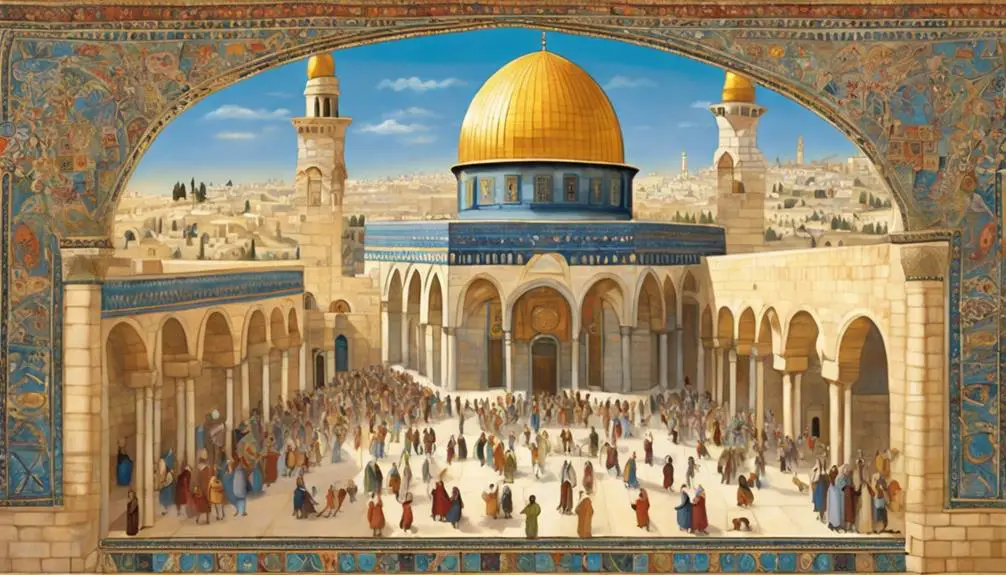
Delving into the 'Songs of Ascents,' we uncover a collection of fifteen Psalms, each serving as a spiritual conduit for pilgrims ascending to Jerusalem for the three major annual festivals. These Psalms, numbered 120 to 134, encapsulate the essence of a pilgrim's journey, both in the physical and spiritual realms. They're intricately woven with themes of distress, deliverance, trust, and ultimately, rejoicing in the presence of the Divine.
Analyzing these Psalms, you'll find that they're not just liturgical texts but are imbued with a profound sense of spiritual elevation. They guide the faithful through a process of inner transformation as they ascend, both metaphorically and literally, towards the sacred space of Jerusalem. This ascent isn't merely a physical undertaking but symbolizes the soul's journey towards closeness with God.
The 'Songs of Ascents' stand as a testament to the deep-rooted spiritual practice of pilgrimage in ancient Judaism. They offer insights into how the act of journeying to a sacred space was intertwined with the pilgrim's internal quest for spiritual purity and enlightenment. Through these Psalms, the pilgrim's journey becomes a mirror for our own spiritual quests, emphasizing the significance of perseverance, faith, and the pursuit of divine connection.
Solomon's Architectural Wonders
Exploring the profound spiritual journey encapsulated in the 'Songs of Ascents' leads us naturally to the architectural marvels constructed under King Solomon, whose works stand as a testament to the zenith of Israel's historical and cultural grandeur. You'll discover that Solomon's era was marked by unprecedented achievements in design and construction, particularly through the Temple he built in Jerusalem. This edifice not only served as a focal point for the nation's worship but also showcased the pinnacle of ancient craftsmanship and divine inspiration.
In analyzing Solomon's architectural contributions, it's essential to highlight:
- The meticulous design and lavish materials used in the Temple furnishings, reflecting both Solomon's wealth and his desire to honor God with the best the earth could offer.
- The integration of motifs from surrounding nations into Temple design, symbolizing a blend of divine wisdom and international influence.
- The significant role of Wisdom literature, initiated by Solomon, in shaping the philosophical and ethical underpinnings of society, which was mirrored in the symbolic elements of the Temple's architecture.
Solomon's architectural wonders, therefore, encapsulate a blend of spiritual devotion, worldly wisdom, and artistic mastery that have left a lasting legacy on biblical history.
The Genealogy of Jesus
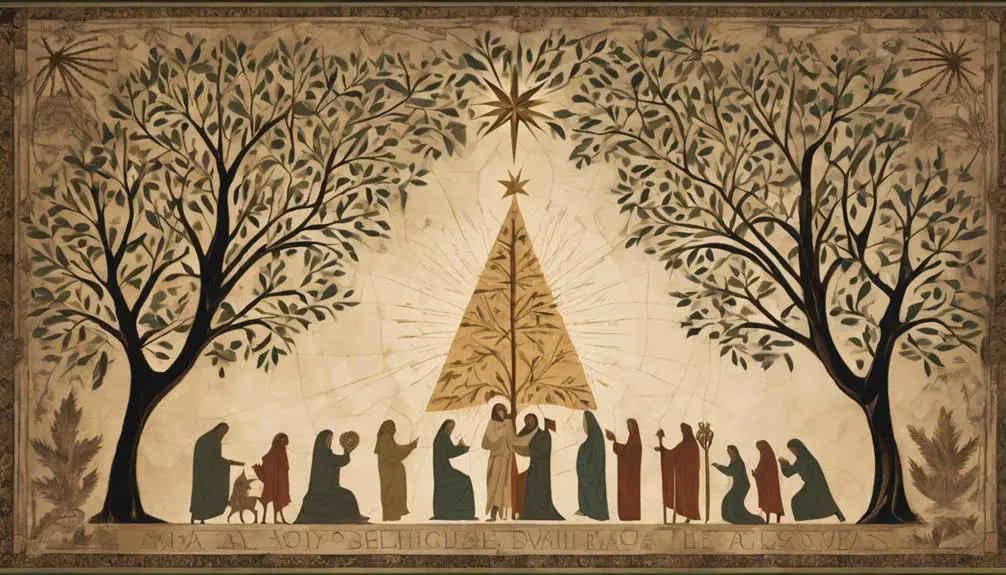
Tracing the genealogy of Jesus offers an intriguing glimpse into the intricate tapestry of biblical history, revealing connections that underscore the fulfillment of ancient prophecies. The genealogy, as recorded in the Gospels of Matthew and Luke, presents a detailed lineage from Adam through to David, and eventually to Jesus, emphasizing his rightful place in the Davidic line. This lineage isn't just a list of names; it's a reflection of God's promise to bring salvation through a specific lineage.
The concept of the Virgin Birth, a cornerstone in Christian theology, further highlights the supernatural aspect of Jesus's entry into the world, aligning with prophecies foretold in the Hebrew scriptures. This miraculous birth, foreseen by prophets, underscores the divine intervention in human history, demonstrating that Jesus's lineage transcended ordinary genealogical bounds.
Moreover, the Baptism Site of Jesus marks a pivotal moment in his life, symbolizing the beginning of his public ministry. It connects his human ancestry with his divine mission, bridging the Old Testament prophecies with their New Testament fulfillment. This moment not only reaffirms his genealogical heritage but also his role as the Messiah, as prophesied.
Psalm 15: A Guide
Psalm 15 poses a pivotal question about moral integrity, asking who may dwell in the Lord's sanctuary, thereby offering a concise yet profound exploration of righteous living. This Psalm intricately weaves together the ideals of moral integrity and righteous living, serving as a guide for those seeking to align themselves with divine expectations. It's not just a list of do's and don'ts; it's an invitation to examine one's heart and actions in the light of God's standards.
Righteous living, as outlined in Psalm 15, encompasses several key attributes:
- Truthfulness: A commitment to honesty in one's dealings and speech.
- Justice: Treating others fairly, without bias or prejudice.
- Integrity: Maintaining moral and ethical principles even when unobserved.
These attributes aren't just lofty ideals; they're practical markers of a life lived in harmony with divine principles. The Psalm effectively distills the essence of moral integrity into actionable behaviors, emphasizing that living righteously isn't an abstract concept but a daily commitment to upholding truth, justice, and integrity.
Esther's Courage
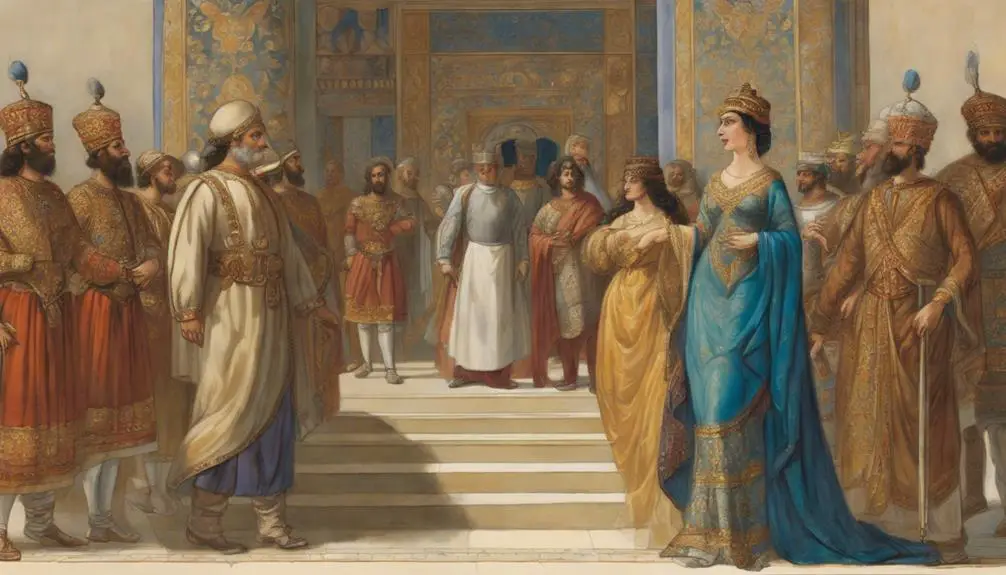
In the biblical narrative, Esther's courage stands as a pivotal example of how individual bravery can catalyze significant social and spiritual change. This account, deeply embedded in the complex fabric of Persian politics, showcases not only Esther's personal valor but also highlights Mordecai's role as a crucial catalyst for her actions. Esther's decision to approach the king, despite the potential for lethal repercussions, underscores a profound commitment to her people and faith. This act of bravery is intricately tied to Mordecai's guidance and the political intricacies of the Persian empire, where the favor of the sovereign could mean life or death.
Mordecai's role is multifaceted; he's not only Esther's cousin and adoptive father but also her advisor, guiding her through the perilous maze of Persian politics. His insight into the political dynamics at play enables Esther to strategically position herself, making her plea for her people not just a personal appeal but a well-calculated political maneuver. This narrative emphasizes the interplay between personal courage and the broader socio-political context, illustrating how Esther's actions, influenced by Mordecai's advisory role and the complexities of Persian politics, lead to a transformative moment for her people.
Proverbs: Wisdom and 15
Reflecting on Esther's narrative of courage and wisdom, we find a parallel theme in the Book of Proverbs, where chapter 15 offers profound insights into the nature of wisdom and its application in daily life. This chapter serves as a guide, touching on various aspects of life, including financial prudence and relationship advice, and highlights the indispensable value of wisdom in these areas.
The essence of Proverbs 15 lies in its detailed, analytical examination of how wisdom informs and transforms. It underscores the importance of:
- Gentle words in diffusing anger, illustrating how wisdom shapes our interactions and nurtures healthier relationships.
- Mindful listening, emphasizing the role of wisdom in understanding and applying advice, particularly in financial matters, fostering prudence and long-term security.
- Constructive criticism, showcasing wisdom's ability to refine character and encourage growth, both personally and in our connections with others.
Proverbs 15 doesn't just offer abstract principles; it provides tangible, actionable advice. It delves into the intricacies of human behavior, advising on how to navigate finances wisely and maintain harmonious relationships. Through its scholarly analysis, it becomes clear that wisdom, as presented in Proverbs 15, isn't merely knowledge but a practical tool for living a fulfilled and balanced life.
Reflections and Revelations

Delving into the heart of the narrative, it's evident that wisdom's revelations serve as a cornerstone for personal and communal transformation. Through the lens of numeric symbolism and Biblical numerology, the number 15 isn't just a figure; it's a profound symbol carrying layers of meaning that transcend its simple numerical value. In understanding this, you unlock a deeper comprehension of the Biblical text, allowing for a richer, more nuanced interpretation.
Aspect |
Description |
Significance |
|---|---|---|
Restitution |
Completion of cycles, restoration |
Divine grace, forgiveness |
Covenant |
God's promises, often sealed on the 15th day |
Unbreakable bonds, divine assurance |
Transition |
Movement from one state to another, often spiritual |
Growth, evolution, divine guidance |
Analyzing Biblical numerology, particularly the number 15, you'll find it's intricately woven with themes of restitution, covenant, and transition. Each of these aspects not only reflects the multifaceted nature of God's interaction with humanity but also offers insights into our own spiritual journey. Hence, the study of numeric symbolism within the Biblical context isn't merely academic—it's a journey into understanding the divine narrative and our place within it.
Frequently Asked Questions
How Does the Number 15 Relate to Modern-Day Numerology and Its Implications for Personal Growth or Spiritual Development?
In modern-day numerology, the number 15 holds significant spiritual significance. It's believed to encourage personal growth and spiritual development.
By engaging with numerology practices, you'll discover that 15 symbolizes manifestation, love, and teaching. Its energy promotes healing, compassion, and altruism.
For you, focusing on the qualities of 15 could unlock profound self-awareness and foster a deeper connection to your spiritual path, enhancing both personal and spiritual evolution.
Are There Any Lesser-Known Biblical Characters or Stories Associated With the Number 15 That Didn't Make Mainstream Biblical Narratives?
You're exploring the depths of lesser-known biblical stories, specifically those intertwined with the number 15. This quest uncovers unique narratives that don't usually make it into mainstream biblical discussions, offering a fresh perspective on spiritual texts.
Delving into these tales, you'll find the fifteen festivities and their genealogical significance not only enrich your understanding but also deepen your appreciation for the intricate layers of historical and spiritual woven into the fabric of biblical literature.
In What Ways Has the Symbolism of the Number 15 Influenced Christian Art and Architecture Outside the Biblical Context?
You're exploring how the abstract concept of the number 15 transcends biblical stories to shape visual culture, particularly in Christian art and architecture.
In the fifteenth century, frescoes and Gothic cathedrals subtly incorporated the symbolism of 15, reflecting themes of redemption and divine grace.
These artistic endeavors, rich in detail and scholarly analysis, reveal how numbers can hold profound cultural and spiritual significance beyond their immediate biblical associations.
How Do Different Translations of the Bible Handle the Number 15, and Are There Any Notable Discrepancies or Interpretations Among Them?
You'll find that translation variances in the Bible often lead to different interpretations of the number 15. Scholars meticulously analyze these differences to understand cultural interpretations and their impacts.
Notably, discrepancies arise due to linguistic nuances and historical context. These variances provide insightful perspectives on how religious texts adapt over time.
It's fascinating to see how each translation navigates these challenges, offering a unique lens through which to view biblical symbolism.
Can the Number 15 Be Found in Any Significant Biblical Prophecies, and How Have These Been Interpreted in Contemporary Religious Thought or Eschatology?
You're diving into a cosmic mystery, where the number 15 shines like a beacon in the night sky. Within the realm of biblical prophecies, it's not explicitly spotlighted, yet its essence weaves through narratives subtly.
For instance, the Purim celebration, deeply rooted in Esther's story, aligns with the 15th of Adar in the Lunar calendar, showcasing a hidden yet profound significance. Scholars analyze these connections, enriching our understanding of eschatological themes and their contemporary interpretations.
Conclusion
As you've journeyed through the tapestry of narratives and teachings, it's clear the number 15 in the Bible isn't just a numeral, but a beacon illuminating paths of liberation, healing, protection, morality, courage, and wisdom.
Like stars in the night sky, each story and verse where 15 appears, guides us toward a deeper understanding of spiritual and moral compasses. Reflect on these revelations, for within them lie keys to unlocking profound truths about the human experience and divine orchestration.



Sign up